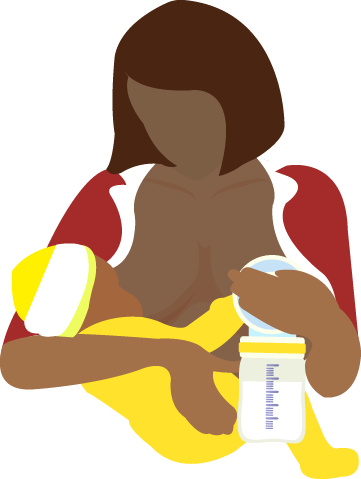Getting started with breastfeeding
Your milk and how you breastfeed change as your baby grows and develops. A newborn’s feeding routine is different than that of a breastfeeding 6 month old. As your baby grows, the nutrients in your milk adapt to your growing baby’s needs. The anti-infective properties also increase if you or your baby is exposed to some new bacteria or virus. Here’s how to get started:
Early breastfeeding
The first few weeks of breastfeeding are a learning period for both you and your baby. It takes time for you both to work as a coordinated team. Be patient as you recover from your delivery, develop a daily routine, and become comfortable with breastfeeding. Keep track of feedings and wet diapers. This can help your child’s healthcare provider assess how your feedings are going.
Day 1
Most full-term, healthy babies are ready and eager to begin breastfeeding within the first half hour to 2 hours after birth. This first hour or 2 is an important time for babies to nurse and be with their mothers. The AAP recommends that babies be placed skin to skin with their mother immediately after birth (or when both you and your baby are able). Skin to skin means placing your naked baby stomach-down on your bare chest. This keeps the baby warm, helps keep the baby’s blood sugar up, and helps the baby breastfeed for the first time. It is recommended that babies be kept skin to skin at least 1 hour, or longer if the baby hasn’t breastfed yet.
After these first few hours of being awake, babies will often act sleepy or drowsy. Some babies are more interested in sleeping than eating on their birthdays. You can expect to change only a couple diapers during the first 24 hours.
Days 2 to 4
Your baby may need practice with latching on and sucking. But by the second day, your baby should begin to wake and show readiness for feedings every 1 1/2 to 3 hours, for a total of 8 to 12 feedings over 24 hours. These frequent feedings provide your baby with antibody-rich first milk (colostrum), and tell your breasts to make more milk. Allow your baby to nurse on one breast until finished. You can then change and burp your baby before you offer the other breast. If the baby is not interested in breastfeeding, start with the second breast at the next feeding.
As with day 1, you probably will change only a few wet and dirty diapers on baby’s second and third days. Don’t be surprised if your baby loses weight during the first couple of days. The number of diaper changes and your baby’s weight will increase when your milk comes in.
It is normal to have uterine cramping during the first few days of breastfeeding. This is a positive sign that the baby’s sucking has triggered a milk let-down. It also means your uterus is contracting, which helps lessen bleeding. A nurse can give you medicine before feeding if needed for the discomfort. Some mothers briefly feel a tingling, pins and needles, or flushing of warmth or coolness through the breasts with milk let-down. Others don’t notice anything different, except the rhythm of the baby’s sucking.
Your baby is still learning. So your nipples may be sore when your baby latches on or during a feeding. Other factors also may contribute to this tenderness, but usually it is mild and goes away by the end of the first week. Tell your nurse if tenderness continues or gets worse, or if your nipples are cracked. Your nurse or healthcare provider may recommend a lactation consultant. This is someone who specializes in breastfeeding.
Days 3 to 5
You will have a lot more milk 3 or 4 days after birth. When the amount of milk increases, the milk is said to have come in. Since your baby is drinking more at each feeding, he or she may drift off after a feeding and act more satisfied. Within 12 to 24 hours, you should be changing a lot more wet diapers. The number of dirty diapers also increases, and the stools should be changing. They will change from meconium, the baby’s first bowel movements, which are sticky and dark, to a mustard-yellow, loose and seedy stool.
Weight gain should also pick up within 24 hours of this increase in milk production, so your baby begins to gain at least 1/2 an ounce (15 g) a day. You may notice that your breasts feel fuller, heavier, or warmer when your milk comes in. The most important thing to do when your milk first comes in is to feed your baby frequently, emptying your breasts often and completely.
Source: Johns Hopkins Medicine
Link: https://www.google.com/amp/s/www.hopkinsmedicine.org/health/conditions-and-diseases/breastfeeding-your-baby/breast-feeding-getting-started%3famp=true




